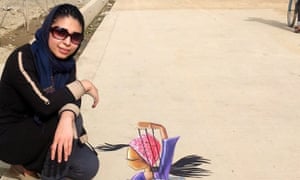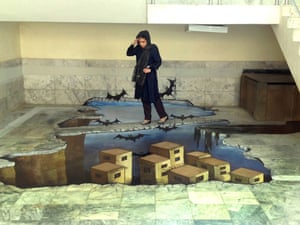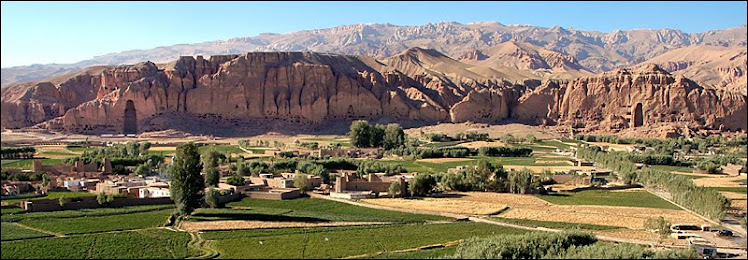Shamsia
Hassani: ‘I want to colour over the bad memories of war’
Afghanistan’s cultural image is changing, thanks in part to the
strong, graceful and dynamic female silhouettes emerging from this bold
graffiti artist’s spray can
Shamsia
beside what's reckoned to be the first ever piece of 3D street art on
Afghanistan. Photograph: Shamsia Hassani/www.kabulartproject.com
Wednesday
17 September 2014

Shamsia beside what's reckoned to be the first ever piece of 3D street art on Afghanistan. Photograph: Shamsia Hassani/www.kabulartproject.com
Just over a decade ago,
the abiding image of art in Afghanistan was theBuddhas of Bamiyan being destroyed by Taliban dynamite,
but Shamsia Hassani is proof of how much has
changed since. Hassani is the country’s foremost graffiti artist, and her work
is respraying Afghanistan’s cultural image.
“I want to colour over the bad memories of war on the walls,”
Hassani told Art Radar last year, “and if I colour
over these bad memories, then I erase [war] from people’s minds. I want to make
Afghanistan famous because of its art, not its war.”
Graffiti has proved the perfect artform for modern-day
Afghanistan, practically as well as metaphorically. It is the ultimate
democratic medium, freely available to spectators and artists alike (save for
the spray-can budget) and capable of transmitting a powerful idea or message
without words (Afghanistan still has one of the world’s lowest literacy rates). Art galleries
are scarce in the ravaged cities, but there are blank walls and pavements in
abundance. Hassani even sprayed one of her pieces on the ruins of Kabul’s
Russian Cultural Centre. And where graffiti is an outlaw activity in the west,
policed with Taliban-like vigilance, in Afghanistan, it is embraced (Hassani
teaches at Kabul University’s faculty of fine arts). For extra irony, she took
up the art after being inspired by British artist, Chu, who held a graffiti
workshop in Kabul in 2010.

A 3D-style floor painting inside the faculty of fine arts, Kabul University. Photograph: Shamsia Hassani
A
3D-style floor painting inside the faculty of fine arts, Kabul University.
Photograph: Shamsia Hassani
Not that Hassani doesn’t have problems. The security situation
is still far from ideal. And being a female artist, she is not always greeted
with enthusiasm when she’s out working. Some regard her as a vandal, others
believe a proper Afghan woman’s place is in the home.
Women are very much Hassani’s subject matter. She often draws
them in stylised blue silhouettes, wearing burqas, or, more recently in a hijab.
They’re far from Taliban-sanctioned stereotypes, though. Hassani’s figures are
active subjects: strong, graceful, dynamic, often depicted emerging from
depths, lost in reflection, even dancing. “I want to show that women have
returned to Afghan society with a new, stronger shape,” she told Art Radar. “It’s not the woman who
stays at home. It’s a new woman. A woman who is full of energy, who wants to
start again.”
• This article was amended on 18 September 2014 to clarify
that the quotes from Shamsia Hassani came from an interview with the website
Art Radar.
http://www.theguardian.com/artanddesign/2014/sep/17/shamia-hassani-i-want-to-colour-over-the-bad-memories-of-war

No comments:
Post a Comment